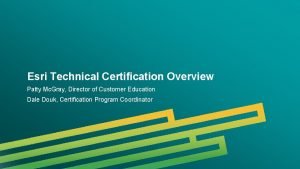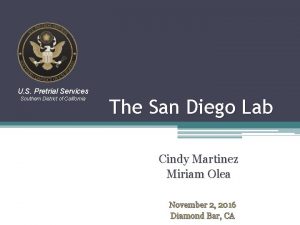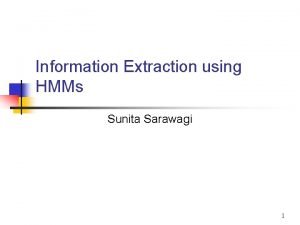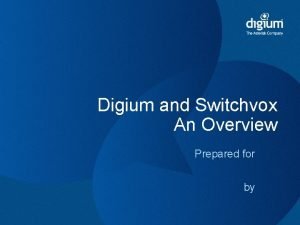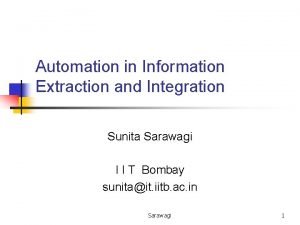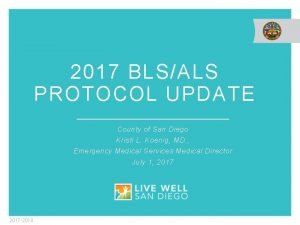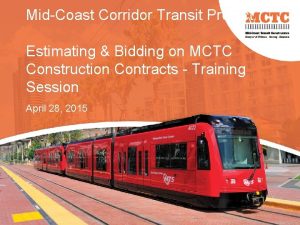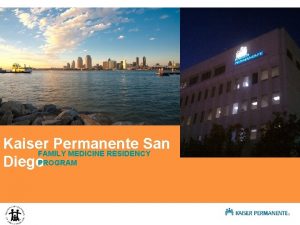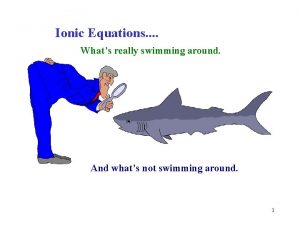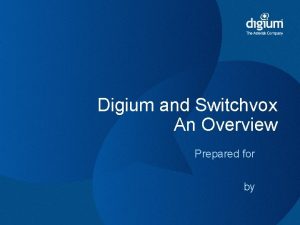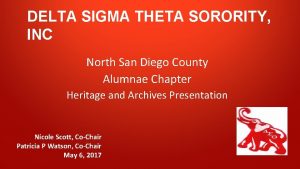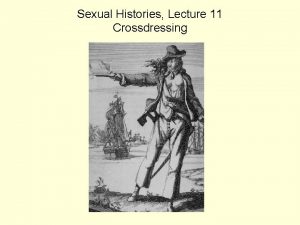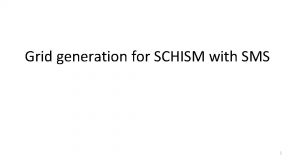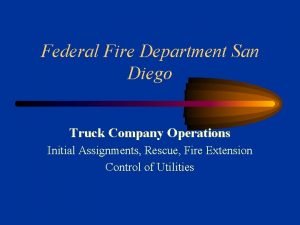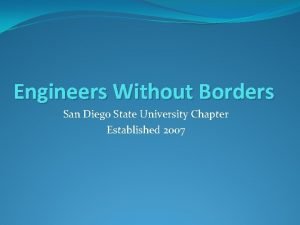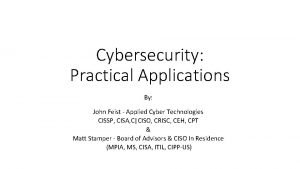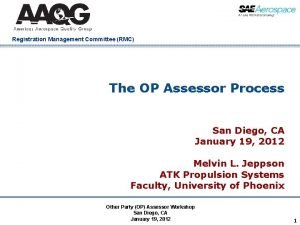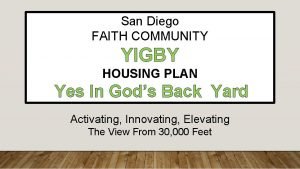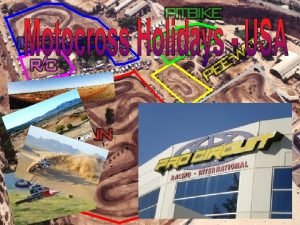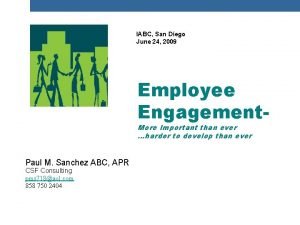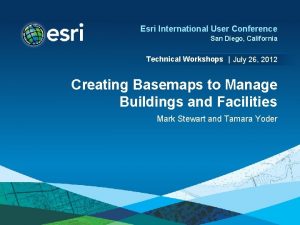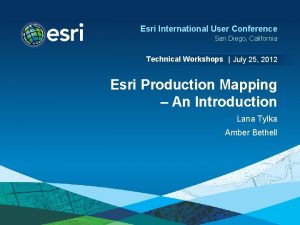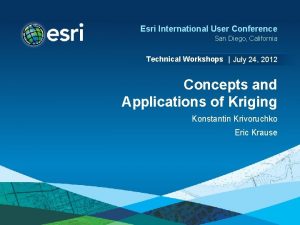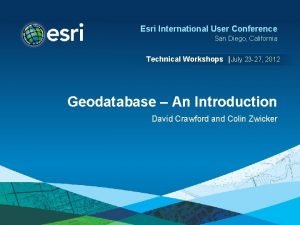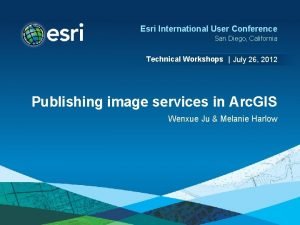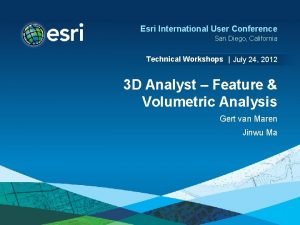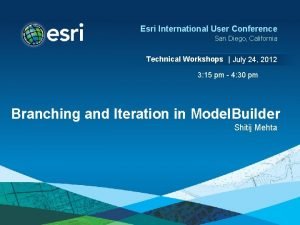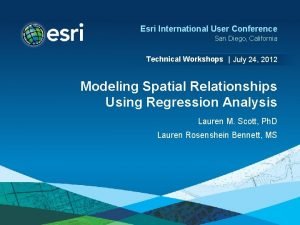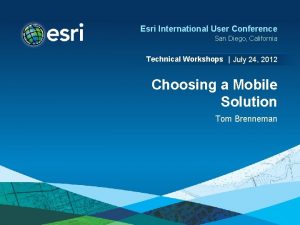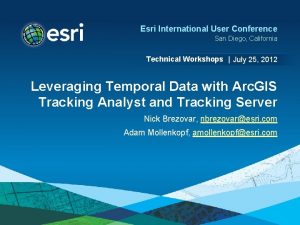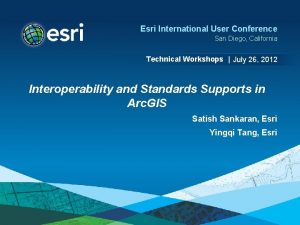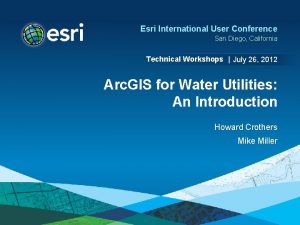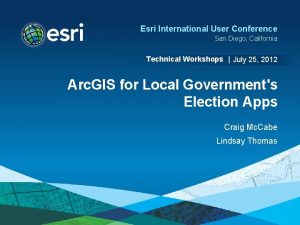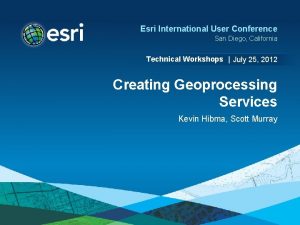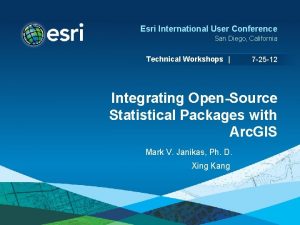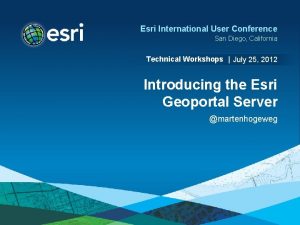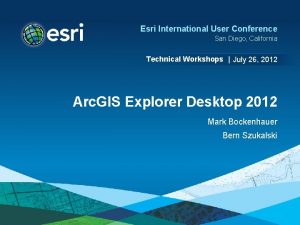Esri International User Conference San Diego California Technical

















































- Slides: 49

Esri International User Conference San Diego, California Technical Workshops | July 25, 2012 Network Analyst Creating Network Datasets Matt Crowder Alan Hatakeyama

Agenda • Preparing street data for use in a network dataset - Oneway streets - Hierarchy - Road. Class attribute • Using turns, signposts, and historical traffic data • Creating a multi-modal network dataset • Parameterized attributes • Evaluators tips and tricks • Support & Resources • Questions

Do I need to create my own network dataset? • • • Street. Map network datasets available - SDC format - Ready to use - Network dataset already created Street. Map data on Data & Maps - Comes with Arc. GIS - Data for North America Street. Map Premium data - Data is more current - Data for North America or Europe

Know Your Street Data • What information can be used as a setting in the network dataset? Documentation Street Information Layer Information Format Geometry Attributes

Review – What is in a Network Dataset? Sources Connectivity Attributes Directions Line features End Point / Any Vertex Z-Elevation fields Connectivity groups Cost Descriptor Restriction Hierarchy Primary street names Alt. street names Highway shields Boundary field Signpost data Point features Turn features

Know Your Street Data

Coincident Geometries • To enable network connectivity to be modeled - Points of coincidence should exist where line features cross or intersect Case 1 Good quality Poor quality Case 2

Creating Coincident Geometry • Include sources in a Topology • Use the Integrate Tool (Geoprocessing) • Both methods compare features and makes vertices within the cluster tolerance coincident - Inserts vertices where features intersect - Snaps features that are not coincident

Common Fields for Street Data Field Data type Application Elevation Integer Oneway Text Length Double Calculate shortest route Travel time Double Calculate fastest route Hierarchy Integer Ranking of streets for routing on large network datasets Speed Integer May be used to calculate travel time Road class Integer Classification of roads – used formatting directions text Street name or address data Text Ensures proper connectivity Helps determine one way streets Helps generate network locations and directions

Connectivity using Elevation Fields • Attribute that enables network dataset to represent multiple “levels” for line features • Applied to line features with coincident endpoints • Planar and non-planar features are supported • Commonly called z-elevation or z-levels 0 FROM endpoint State St 0 TO endpoint NAME F_ZLEV T_ZLEV State St 0 0 Endpoint Line feature

Elevation Fields – Overpass/Underpass Scenario • Four lines with coincident endpoints 0 0 1 0 0 0 Junction Endpoint 0 -1 lines do not intersect 0 -0 lines at the same junction

Oneway field – Most common method • Text field containing values: FT, TF, < >, N - “FT” – one-way in digitized direction F_endpoint NAME Oneway State St FT - FT = traffic only allowed in this direction “TF” – one-way against digitized direction F_endpoint NAME Oneway State St TF - T_endpoint <empty> – two-way street NAME Oneway State St <> T_endpoint TF = traffic only allowed in this direction “N” – No travel NAME Oneway State St N If other field values, change expression

Hierarchy • Minimizes impedance while favoring higher order roads • Basic assumption: - • Higher order roads are “faster” (time), not necessarily “shorter” (distance) Hierarchy classifies network edges into multiple levels when the network dataset is built - Levels: lower number = higher order road

Hierarchy Considerations • Highest level needs to be connected to each other - • Take restrictions into consideration Composition of highest level hierarchy dictates performance vs. accuracy of route returned - Larger: more optimal routes, but is slower - Smaller: faster performance, but route is less optimal • Values derived from road classification (e. g. , CFCC) • Edges per hierarchy guide: Hierarchy 1 2 3 Regional National % of edges 5% 15% 80% Edge count 3% 17% 80% better guide ~100, 000 max Percentage of total

Road. Class attribute • Used formatting the text of driving directions • Has no effect on network analysis • Descriptor attribute, five possible integer values: Road. Class Value Road. Class Description Driving Directions 1 Local road “Turn left on Main St” 2 Limited access highway “Go East on I 44” 3 Ramp “Take ramp and go on US-7 N” 4 Ferry “Take Lake Expy ferry” 5 Roundabout “Take roundabout and proceed South on Main St”

Dissolve Network • Input: Network dataset • Output: New network dataset with fewer line features - • A North America: 43. 8 M lines –» 15. 7 M lines Fewer line features – Faster network analysis

Dissolve Network • Speeds up network analysis for large networks • Geoprocessing tool in Network Dataset toolset • Creates a new dissolved network dataset - • Original network dataset is unedited Only fields used by network dataset are present in dissolved data - Use dissolved dataset for network analysis - Keep original data for maintenance and other work

Demonstration Adding fields for routing to TIGER/Line® street data

Turns in the Network Dataset • Describe transitions between two or more edges • Used to model cost and/or restrictions in the network • Incorporating turn elements – more realistic network solver results • Two options: - Turn features - Global (default) turns - Or Both

Turn Feature 102 101 103 104 • Polyline geometry • Turn references edges by: • - Feature class ID - Feature ID - Position Turn elements built by edge references Field Object. ID Shape Edge 1 End Edge 1 FCID Edge 1 FID Edge 1 Pos Edge 2 FCID Edge 2 FID Edge 2 Pos Edge 3 FCID Edge 3 FID Edge 3 Pos Value 1 Polyline Y 42 104 0. 5 42 102 0. 6 42 103 0. 4

Editing Turn Features • Create and edit turn features in the Arc. Map Editor • Edit as you would any other line feature • Snap geometry to each street in turn • Network dataset must be built before editing turn features

Global Turns • For example – adding a penalty for all left turns • Consist of: - All implied two-edge turning sequences in network - No need to create a turn feature for every two-edge sequence in the network Turn feature Global left turn • Specify attribute values for global turns - VB Script evaluator –or– Global Turn Delay evaluator

Sample VB Script Code for Global Turn Penalty Straight 0/360 Pre-Logic VB Script Code: a = Turn. Angle If a > 210 And a < 330 Then turn. Time = 0. 5 Else turn. Time = 0 End If 30 330 270 Left turn Right turn 90 Expression: turn. Time 150 210 180 U- turn

…or use the Global Turn Delay evaluator

Signposts • Text seen on highway signs - Typically includes exit number, street name, and/or destination • Has no effect on network analysis • Enhances text of driving directions: - “At exit 73 B, take ramp to US-421 North toward N Wilkesboro”

Signpost Data – Two tables EXIT • Signpost feature class - • 73 B Actual text on sign Exit number 73 B Street name(s) US-421 Direction North Destination(s) N Wilkesboro NORTH N Wilkesboro Signpost streets table - Streets traversed when following the sign Feature class ID 12 Feature ID 41 Positions 0. 0 to 1. 0 For Vendor data use “Import Signposts”. NET SDK Developer sample

Adding Signposts to the Network Dataset • Signpost tables specified in the Directions Settings

Historical Traffic • • Travel time varies by time of day and/or day of week - Travel at 8 am: - Travel at 5 pm: Used by Network Analyst when a Start Time is specified for the route

Historical Traffic Data – Two tables • Traffic Profiles table - • Contains free-flow speed multipliers by time of day Profile 1 am 5 am 9 am 1 pm 5 pm 9 pm 16 × 1. 0 × 1. 1 × 2. 3 × 1. 2 × 1. 4 × 1. 1 Streets-Traffic Profiles join table - Specifies free-flow travel times and profiles to use Feature class ID 12 Feature ID 41 Positions 0. 0 to 1. 0 Free-flow travel 10 seconds Sunday Profile 10 Monday Profile … Profile 16 …

Historical Traffic in the Network Dataset • Specify when creating the network dataset

Demonstration Using Turns, Signposts, and Historical Traffic Data

Connectivity for Multi-Modal Network Dataset • Connectivity groups “connect” at transfer points - • Example: Rail stations Non-connecting edge sources in separate connectivity groups Transfer Point Metro Streets (connectivity group 1) (connectivity group 2)

Multi-Modal – considerations for Road & Rail • • Road & Rail example – two common scenarios: - Railroad station not on rail track - Railway station entrance along middle of road For Railroad stations not along the road - Create “transfer edges” Rail Station Entrance Transfer Edge • For station entrances not at the road ends - Create junction with Override policy at entrance - Insert vertex on street feature at station entrance

Network Attributes – Multi-Modal Network Dataset • • Create a cost attribute for each scenario you are modeling - Automobile - Pedestrian (walk only) - Pedestrian using light rail - etc. Create restriction attributes to prevent invalid traversals - Example: Restrict driving on the rail lines

Demonstration • A multi-modal network dataset Walking paths Streets Railway

Parameterized Attributes • Network attribute that accepts a parameter • Used to model dynamic aspect of an attribute’s value Parameterized attribute Input Parameter value(s) (Optional) Other Network Attribute(s)

Example – implementing a height limit • Requires both a Descriptor and a Restriction attribute • Descriptor attribute - • Bridge clearance: 12’ 6” Specifies height limits for each road Restriction attribute - Stores vehicle height parameter • Performs the appropriate restriction • May use Function evaluator or VB Script evaluator - Function evaluator – faster & easier Restriction evaluates to True (Restricted) if vehicle height exceeds 12 ft, 6 in

Using Height restriction during solve • • When using solver: - Set attribute restriction on Analysis Settings tab - Specify actual vehicle height on Attribute Parameters tab Solver Result: - Street is restricted when the actual Vehicle Height is greater than street’s Max. Height attribute value Truck height: 16’ Car height: 6’ Bridge clearance: 12’ 6” Bridge

Evaluators – review • A function that determines attribute values for network elements in a network dataset • Six different types available with Arc. GIS: • - Field - Constant - Global Turn Delay - Function - Edge Traffic - VB Script Example usages: Attribute Length Travel. Time Turn. Restriction Max. Height Evaluator(s) Field – assign the [meters] field Edge Traffic, Global Turn Delay – use historical traffic, turn delays Constant – “true” (implies all turns restricted) Field – assign the [Height_Limit] field Height. Restriction Function – specify Max. Height attribute < Vehicle. Height parameter • Custom evaluators can be developed

Efficiency of calling evaluators • Field evaluator (including Field Expressions) - • Constant, Function, & Global Turn Delay evaluators - • Fast: Multipliers & free-flow values stored when network is built; Travel time determined during solve VB Script evaluator - • Fast: Attribute values generated at solve time using precompiled logic Edge Traffic evaluator - • Fast: Attribute values stored when network is built; Retrieved at solve time Can be slow: Invokes scripting at solve time Custom evaluator: Depends on implementation

Evaluators – Tips and Tricks • Field evaluator - Read in values from a field; and/or - Perform calculations using multiple field values - • Constant evaluator - Same attribute value across all network elements - • Example attributes: Length, Drive. Time, Oneway Example attribute: Turn. Restriction Custom logic - Initial prototyping with VB Script evaluator - Final implementation using Custom evaluator - Better performance

Support & Resources

Esri Support Center • Online portal to technical information • Knowledge Base • • - Technical articles - White papers Community - Discussion Forums - E-mail lists Downloads - Patches & service packs - Arc. Scripts and samples - Data models http: //support. esri. com

For more information • • Network Analyst product page - Links to Demos, Brochures/White Papers, Success Stories - http: //www. esri. com/software/arcgis/extensions/networka nalyst/ Free recorded training seminar - Using Network Analyst in Arc. GIS Desktop 10 - http: //training. esri. com/gateway/index. cfm? fa=catalog. we b. Course. Detail&Course. ID=1955

Network Analyst Technical Workshops • • • Network Analyst – An Introduction - Tuesday 8: 30 AM, Room 3 - Wednesday 1: 30 PM, Room 4 Network Analyst – Performing Network Analysis - Tuesday 10: 15 AM, Room 3 - Thursday 10: 15 AM, Room 4 Network Analysis with Arc. GIS for Server - • Tuesday 1: 30 PM, Room 3 Automating Workflows with Geoprocessing - Wednesday 8: 30 AM, Room 10

Network Analyst Demo Theater Presentations • Modeling Real-World Problems with the VRP Solver - • • Routing with Open Source Data (OSM) - Tuesday 10: 00 AM, Esri Labs Island - Wednesday 1: 00 PM, Esri Labs Island What’s New in Network Analyst 10. 1 - • Tuesday 9: 00 AM, Analysis & Geoprocessing Island Tuesday 5: 00 PM, Analysis & Geoprocessing Island Routing in Buildings with 3 D Networks - Thursday 11: 00 AM, Analysis & Geoprocessing Island

Steps to evaluate UC sessions • My UC Homepage > “Evaluate Sessions” • Choose session from “My Planner” OR • Search for session by Offering ID: 748 www. esri. com/ucsessionsurveys

• Thank you for attending • Have fun at UC 2012 • Open for Questions • Please fill out the evaluation: www. esri. com/ucsessionsurveys First Offering ID: 748 Second Offering ID: 912

 Esri technical certification
Esri technical certification Pearson vue esri
Pearson vue esri San diego continuing education north city campus
San diego continuing education north city campus Universal design san diego
Universal design san diego San diego pretrial services
San diego pretrial services Parentvue san marcos
Parentvue san marcos Mental health america of san diego county
Mental health america of san diego county Sarawagi san diego
Sarawagi san diego Switchvox san diego
Switchvox san diego Conchiglia della santissima trinità
Conchiglia della santissima trinità Sarawagi san diego
Sarawagi san diego San diego county lemsis
San diego county lemsis Heraus ragen
Heraus ragen Ornithology science olympiad
Ornithology science olympiad Mid coast corridor transit project
Mid coast corridor transit project Kaiser san diego family medicine residency
Kaiser san diego family medicine residency 446 alta road, suite 5300
446 alta road, suite 5300 San diego imperial swimming
San diego imperial swimming Switchvox san diego
Switchvox san diego Delta sigma theta san diego
Delta sigma theta san diego Biology workbench
Biology workbench Crossdressing san diego
Crossdressing san diego San diego restorative justice
San diego restorative justice Imperial swimming
Imperial swimming San diego housing commission
San diego housing commission Iia san diego
Iia san diego San diego sms satellites
San diego sms satellites Federal fire san diego
Federal fire san diego San diego department of environmental health
San diego department of environmental health San diego to nagoya
San diego to nagoya San diego grace fellowship
San diego grace fellowship Engineers without borders san diego
Engineers without borders san diego Cryptlock san diego
Cryptlock san diego Science olympiad experimental design practice test
Science olympiad experimental design practice test Active ride shop locations
Active ride shop locations Aacs san diego
Aacs san diego Movimento d'amore san juan diego
Movimento d'amore san juan diego San diego gdp
San diego gdp San diego sports commission
San diego sports commission Opassessor
Opassessor Elsevier san diego
Elsevier san diego Yigby san diego
Yigby san diego San diego biz law
San diego biz law Ucsd summer session
Ucsd summer session Iabc san diego
Iabc san diego E10 esrb
E10 esrb Delta sigma theta san diego
Delta sigma theta san diego Cleaning the tides of san diego and tijuana
Cleaning the tides of san diego and tijuana Bachillerato internacional las rozas
Bachillerato internacional las rozas Age cka
Age cka
